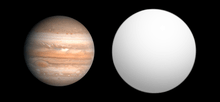HAT-P-2b
HAT-P-2b is an extrasolar planet detected by the HATNet Project in May 2007. It orbits a class F star, (bigger and hotter than the Sun), located about 420 light-years away in the constellation Hercules. Every 5 days 15 hours, it crosses directly in front of the star as viewed from Earth.[1][2]
 Size comparison of HAT-P-2b with Jupiter. | |
| Discovery | |
|---|---|
| Discovered by | HATNet Project[1] |
| Discovery date | 2007-05-01[2] |
| Transit | |
| Orbital characteristics | |
| 0.06880+0.00065 −0.00070 AU | |
| Eccentricity | 0.50833+0.00082 −0.00075[3] |
| 5.6334729±0.0000061 days[4] d | |
| Inclination | 85.97+0.28 −0.25[5] |
| 2455289.4721±0.0038[5] | |
| 188.09±0.39[5] | |
| Semi-amplitude | 983.9±17.2[4] |
| Star | HD 147506 |
| Physical characteristics | |
Mean radius | 1.106±0.061[5] RJ |
| Mass | 8.70+0.19 −0.20[3] MJ |
Mean density | 7300±1600 kg m−3 |
| 162±27 m/s² | |
| Temperature | 1187[6] |
The planet HAT-P-2b is named Magor. The name was selected in the NameExoWorlds campaign by Hungary, during the 100th anniversary of the IAU. Magor was a legendary ancestor of the Magyar people and the Hungarian nation, and brother of Hunor (name of the star HAT-P-2).[7][8]
Orbit and mass
The planet's mass has been estimated to be 8.65 times that of Jupiter, while its diameter, at 135,978 km (84,493 mi), is 0.951 times Jupiter's. Its small size, despite the bloating of the planet's atmosphere, is caused by the strong gravity of the planet. This indicates its mean density is twice that of Earth and its surface gravity approximately 24 times that on Earth, almost equal to the Sun. The orbit is very eccentric, ranging from 4.90 million to 15.36 million miles from the star.[2]
In addition to heat from its primary star, tidal heating is thought to have played a significant role in this planet's evolution.[9]
Rotation
As of August 2008, the most recent calculation of HAT-P-2b's Rossiter–McLaughlin effect and so spin-orbit angle was that of Winn in 2007 but Loeillet has in 2008 disputed it.[10][11] For Winn this is +1 ± 13 degrees.[12] The study in 2012, have determined the planetary orbit is probably aligned with the rotational axis of the star, misalignment equal to 9±10°.[13]
It has been suggested that there is a second outer planet perturbing HAT-P-2 b, although thus far, this has neither been proven or disproven.[2]
References
- Bakos, G. Á.; et al. (2007). "HD 147506b: A Supermassive Planet in an Eccentric Orbit Transiting a Bright Star". The Astrophysical Journal. 670 (1): 826–832. arXiv:0705.0126. Bibcode:2007ApJ...670..826B. doi:10.1086/521866.
- Aguilar, David A.; Pulliam, Christine (2007-05-01). "Astronomers find super-massive planet" (Press release). Harvard-Smithsonian Center for Astrophysics. Retrieved 2019-01-05.
- Bonomo, A. S.; et al. (2017). "The GAPS Programme with HARPS-N at TNG . XIV. Investigating giant planet migration history via improved eccentricity and mass determination for 231 transiting planets". Astronomy and Astrophysics. 602 (107): A107. arXiv:1704.00373. Bibcode:2017A&A...602A.107B. doi:10.1051/0004-6361/201629882.
- Pál, András; et al. (2010). "Refined stellar, orbital and planetary parameters of the eccentric HAT-P-2 planetary system". Monthly Notices of the Royal Astronomical Society. 401 (4): 2665–2674. arXiv:0908.1705. Bibcode:2010MNRAS.401.2665P. doi:10.1111/j.1365-2966.2009.15849.x.
- Lewis, Nikole K.; et al. (2013). "Orbital Phase Variations of the Eccentric Giant Planet HAT-P-2b". The Astrophysical Journal. 766 (2): 95. arXiv:1302.5084. Bibcode:2013ApJ...766...95L. doi:10.1088/0004-637X/766/2/95.
- Ravilious, Kate (May 3, 2007). ""Weird" New Planet Weighs as Much as 2,500 Earths". National Geographic News. Retrieved 2007-05-04.
- "Approved names". NameExoworlds. Retrieved 2020-01-02.
- "International Astronomical Union | IAU". www.iau.org. Retrieved 2020-01-02.
- Jackson, Brian; et al. (2008). "Tidal Heating of Extra-Solar Planets". Astrophysical Journal. 681 (2): 1631. arXiv:0803.0026. Bibcode:2008ApJ...681.1631J. doi:10.1086/587641.
- Joshua N. Winn (2008). "Measuring accurate transit parameters". Proceedings of the International Astronomical Union. 4: 99–109. arXiv:0807.4929. Bibcode:2009IAUS..253...99W. doi:10.1017/S174392130802629X.
- Loeillet, B.; et al. (2008). "Refined parameters and spectroscopic transit of the super-massive planet HD 147506b". Astronomy and Astrophysics. 481 (2): 529–533. arXiv:0707.0679. Bibcode:2008A&A...481..529L. doi:10.1051/0004-6361:20078167.
- Winn; et al. (2007). "Spin-Orbit Alignment for the Eccentric Exoplanet HD 147506b". Astrophysical Journal Letters. 665 (2): L167. arXiv:0707.0503. Bibcode:2007ApJ...665L.167W. doi:10.1086/521362.
- Obliquities of Hot Jupiter host stars: Evidence for tidal interactions and primordial misalignments, 2012, arXiv:1206.6105
External links
![]()